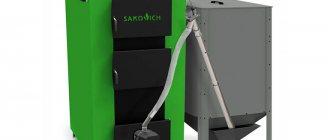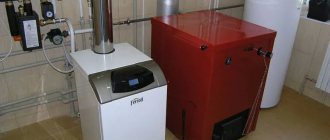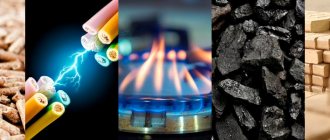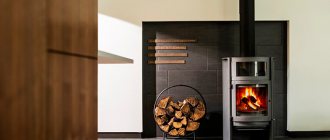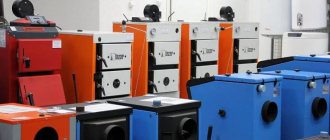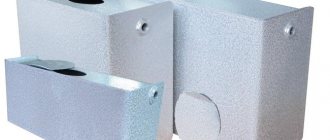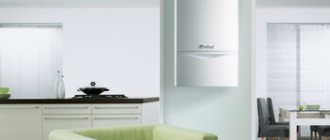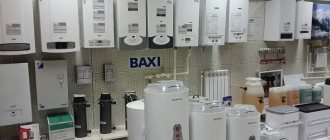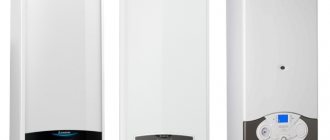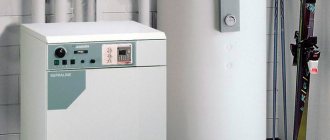The concept of a solid fuel cast iron boiler primarily implies the installation of a cast iron sectional heat exchanger in the boiler - the most important structural element that transfers the thermal energy of fuel combustion to the coolant. The properties and characteristics of the boiler unit as a whole depend on the material of manufacture of the heat exchanger and its design.
In the article we will look at all the differences between solid fuel boilers with a cast iron heat exchanger and analogues with a steel heat exchanger, and we will give a rating of the most successful modern models.
What are cast iron solid fuel boilers?
Traditional cast iron solid fuel Attack FD.
The main distinguishing property of cast iron models is the resistance of cast iron to corrosion. Steel heat exchangers have not so thick walls, the resource of which is simply limited by the physical properties of the metal. After 12-15 years, the metal is destroyed and the heat exchanger leaks. The situation can be slightly improved only by using purified and softened coolant.
Cast iron heat exchangers have thicker walls, and the metal does not corrode; after many years it can only be slightly covered with a rusty crust on the outside. Therefore, their service life when using any coolant is over 30 years.
Only light rust inside the cast iron heat exchanger sections after over 7 years of use.
However, there are many known disadvantages: first of all, fragility. It is necessary to transport and install cast iron boilers with extreme caution; even minor mechanical damage can lead to cracks or destruction of sections. The situation is aggravated by the huge weight of such models - on average 150-220 kg, versions with a power of 40 kW or more can weigh over 300 and even 400 kg.
The cast iron heat exchanger consists of sections firmly connected to each other. The boiler power depends on the number of sections. Unlike solid steel, a damaged section of a cast iron heat exchanger can be easily replaced.
Fragility also manifests itself in sensitivity to sudden temperature changes, for example, a large difference between the supply and return lines. In addition to carefully monitoring the temperature difference, the problem can be solved by installing a four-way mixing valve, through which a certain volume of heated coolant from the supply is mixed into the return line. To mitigate the above-described disadvantages, some leading manufacturers make the heat exchanger from more advanced alloys, for example, from gray cast iron alloys. However, the cost of such models is 20-50% higher.
The advantage and at the same time disadvantage of cast iron heat exchangers is their high inertness. Cast iron takes longer to heat up, but also continues to transfer thermal energy to the coolant much longer. However, it is impossible to precisely adjust the operation of the boiler or quickly change the desired temperature level.
In cast iron solid fuel boilers you can burn wood, coal, wood briquettes, pellets, and peat. Almost all models are capable of working on any type, however, there are also models whose design means working only on wood.
There are both single-circuit, intended only for heating, and double-circuit models, intended for heating and hot water supply to the house. The power of household cast iron boilers varies between 8-120 kW.
Long burning boilers
Separately, it is worth highlighting long-lasting models, in which the burning time of one load is 2-5 days. This result is achieved by increasing the volume of the firebox and a more economical top-down combustion principle.
Often, long-burning solid fuel cast iron boilers are more technologically advanced and can be equipped with advanced automation. Despite the cast iron heat exchanger, the body is often made of steel, which reduces the weight and cost of the boiler. However, such models still cost 1.5-2 times more.
Boilers with a burning duration of one load of fuel up to 7 days
Criterias of choice
Every year, choosing a boiler becomes more and more difficult, since the market is saturated with all kinds of modifications. For an inexperienced developer, before purchasing a unit, it is better to turn to professionals for advice.
There are a number of indicators that you need to pay attention to before purchasing a heating device:
- Type of base fuel, especially for multi-fuel units.
- Boiler weight, in order to take into account installation conditions.
- Thermal power so that the boiler maintains a sanitary temperature in a private house at the lowest outdoor temperatures for the climate zone of the location.
- The volume of the loading chamber ensures continuous operation time on one load.
- Number of heating circuits: for heating only or for heating and domestic hot water.
- The efficiency and efficiency of modern cast iron boilers reach 92%. You should not take units with lower performance, as this will cause an increase in the cost of thermal energy.
- Automation of safety and regulation.
- Energy independence.
Reviews of domestic heating boilers with a cast iron heat exchanger: advantages and disadvantages
| Advantages | Flaws |
| Longer service life - ensured by corrosion resistance and thick heat exchanger walls | Higher cost - cast iron models are 30-200% more expensive than steel counterparts |
| There is a less frequent need for flushing - practically no scale forms in cast iron heat exchangers. According to installation practice and owner reviews, it is enough to wash the heat exchanger every 8-12 years, while steel ones require regular cleaning every 3-5 years | Heavy weight - in the range of 150-450 kg, which complicates transportation and installation and increases the requirements for flooring |
| High inertness - cast iron retains and transfers heat to the water circuit longer | Vulnerability to mechanical damage |
| Wide choice - there are enough domestic and foreign models on the market, almost all of them are non-volatile | Vulnerability to sudden changes in temperature |
| Power range - unlike steel analogues, there are enough models on the market with a power of over 50-60 kW | High inertia is also a disadvantage, since the boiler is difficult to adjust |
| Higher operating pressure in the water circuit - the limit of steel heat exchangers is on average 1.5-2 bar, while cast iron is up to 4-5 bar, which allows their use in closed heating systems of large, two- or three-story houses |
4.4. Steel hot water boilers of the KV-TSi series KV-TSV
Hot water boilers of the KV-TS series with a layered method of burning solid fuel are produced with a heating capacity of 4; 6.5; 10; 20; thirty; 50 Gcal/h (4.7; 7.5; 11.7; 23.4; 35 and 58.5 MW). Boilers of this series are intended for installation at thermal power plants, in industrial heating and heating boiler houses. Water heating boilers of the KV-TSV series differ from boilers of the KV-TS series only in the presence of an air heater.
All hot water boilers of both these series have combustion screens made of pipes with a diameter of 60 x 3 mm. Convective bags in them are made from pipes with a diameter of 28 x 3 mm. The boilers are equipped with chain return grates with pneumomechanical fuel throwers.
Hot water boilers KV-TS-4 and -6.5 have a convective shaft (Fig. 4.3) with a heating surface and a combustion chamber
Rice. 4.3. Water heating boilers KV-TS-4 and -6.5 :
1 - window for the exit of combustion products from the combustion chamber; 2 - convective shaft with heating surface; 3 - nozzle for returning fuel carryover to the chain grid; 4 - slag bunker; 5 - reverse chain grille; 6 — pneumomechanical fuel thrower; 7 — fuel bunker; 8 - combustion chamber
camera; GHG - combustion products
Fuel (coal) from the hopper 7 is supplied to the return chain grid 5 by means of a pneumo-mechanical spreader. Air for fuel combustion is supplied by a fan into the ducts, through which it is sectioned and supplied under the chain grate. The fuel combustion products from the combustion chamber enter the convective shaft through the upper openings in the rear wall of the combustion chamber (windows). The heat of the GHG is perceived by convective heating surfaces in convective shaft 2, and cooled GHGs are removed from the boiler through a gas duct located in the lower part of the convective shaft. With the GHG flow Fuel is partially carried away from the combustion chamber; to catch it, a special fan is installed in the convection shaft bunker, which returns the carried away fuel through the nozzles to the combustion chamber onto the chain grate.
equipped with chain return grids 7 of different lengths and two pneumomechanical fuel throwers. In the rear part of the combustion chamber there is an intermediate shielded wall 6, forming an afterburning chamber. The screens of the intermediate wall are made of two rows. The side walls of the combustion chamber, as well as the convection shaft, have lightweight lining. The front wall of the combustion chamber is not shielded and has heavy lining.
The front and rear walls of the convection shaft are shielded. The front wall of the convective shaft, which is also the rear wall of the combustion chamber, is made in the form of an all-welded screen, turning into a four-row scallop at the bottom. The side walls of the convective shaft are closed with vertical screens made of pipes with a diameter of 83 3.5 mm.
Combustion products enter the convective shaft from below and pass through the festoon. The shaft contains packages of convective heating surfaces made in the form of horizontal screens. Collected fines and unburned fuel particles are collected in ash bins under the convective shaft and, through the entrainment return system, are thrown into the combustion chamber through pipeline 5. In the front part of the return chain grate 7 there is a slag hopper, where slag is dumped from the grate.
The supply of network water to the boiler is carried out through the lower collector of the left side screen, and the output of hot water is through the lower left collector of the convective shaft.
For burning wet brown coals, boilers of the KB-TS series can be supplied with air heaters that provide air heating to 200...220 °C.
The water heating boiler K.V-TS-50 has a screened combustion chamber (Fig. 4.5), a chain return grate to which fuel is supplied by four pneumo-mechanical throwers. The rear screen of the combustion chamber at the entrance to the rotary chamber is opened into a four-row festoon. The walls and slopes of the rotary chamber, and Also, the rear wall of the convective shaft is shielded with pipes with a diameter of 60 x 3 mm. Convective heating surfaces are made in the form of U-shaped screens made of pipes with a diameter of 28 x 3 mm, which are welded to vertical pipes with a diameter of 83 x 3.5 mm, forming screens for the side walls of the convective shaft.
Behind the boiler there is a two-pass tubular air heater in the form of two cubes made of pipes with a diameter of 40 x 1.5 mm. The boiler is equipped with a fan 7 and devices for returning fuel carryover from the ash bins under the convective shaft and under the air heater to the grate. Secondary sharp blast is carried out through nozzles located on the rear wall of the firebox using a fan. The slag produced by burning fuel is dumped into the mine. To clean convective heating surfaces, a shot cleaning device is provided (shot cleaning unit 5).
The best known manufacturers and models: characteristics and prices
Protherm Beaver 20 DLO
The well-known Slovak-made model with a power of 19 kW is one of the best cast-iron solid fuel boilers for heating a private home. It is characterized by high efficiency and fast heating of the heating system (thanks to a two-pass heat exchanger and an excellent cast iron alloy with an efficiency of 90.2%), as well as high-quality assembly and ease of operation.
Almost all owners note the acceptable dimensions of the firebox window, through which firewood up to 30-32 cm can easily fit, the convenient design of the boiler in general and the ash drawer in particular (large, easily removed, fairly easy to maintain). The model does not require connection to the electrical network.
During installation practice and more than 6 years of operation, these boilers have shown excellent trouble-free operation. The only disadvantages are traditionally the large weight and the insufficiently deep firebox, as a result of which an increased amount of ash may fly out of it when additional firewood is added.
How to accurately calculate the required boiler power Individual calculation, formula and correction factors
Viadrus Hercules U22 C-3
Another excellent Czech-made boiler with a power of 17.7 kW. Unlike the previous model, it has a lower efficiency - up to 80% and more noticeable dimensions. However, it has lower fuel requirements: you can use wood with a moisture content of more than 25% and a length of up to 34-35 cm, coal with a high ash content, and you can burn anthracite. However, please note that the size of the firebox depends on the boiler version.
The boiler is still easy to operate and maintain (huge window for loading fuel, convenient ash pan, easy to clean). Known for its operational practice for high-quality assembly and high reliability.
Kentatsu Furst ELEGANT-03
A good inexpensive model of Japanese design, but Turkish production and assembly, with a power of 17 kW. It is distinguished by its extremely affordable cost, good efficient design of the heat exchanger with an increased surface area, which increases efficiency, and the presence of a thermal insulation layer that reduces heat loss through the boiler body. Moreover, the model has compact dimensions.
However, the disadvantages characteristic of similar models in the budget price segment are mediocre build quality, a small firebox and the duration of combustion of one load. It is also worth noting that the service structure in Russia is not so developed even in large regional centers.
Cost: 35,000-36,900 rubles.
KChM -5-K-03M1
Russian-made model with a power of 21 kW. It is distinguished by its absolute “omnivorousness” (works on wood, peat briquettes, pellets, coal and charcoal, anthracite, can be converted to gas or liquid fuel), as well as its compact size, large firebox window and low requirements for operating conditions (fuel quality, traction , coolant).
However, the boiler is also known for many problems: poor-quality assembly, lower efficiency compared to analogues (77.6%), small ash volume, unjustifiably increasing price every year. In general, there is a tendency for quality to deteriorate and the number of complaints to increase. Although the model has long been superior to many analogues not mentioned in the article, which is why it has gained popularity, today we recommend choosing one of the above-mentioned foreign boilers.
Cost: 47-56 thousand rubles.
Installation procedure
In general, the installation of cast iron boilers is not difficult, however, it must be entrusted to a specialized organization that has the appropriate license, especially in relation to boilers running on natural gas.
In addition to gas workers, such requirements for installation work are imposed by almost all Western manufacturers for warranty service.
Domestic factories are less demanding; some even issue detailed instructions for installation and assume that it will be carried out by the boiler owner himself.
Schematic diagram of the installation work of a cast iron boiler:
- Preparing the room for installing the unit: foundation, lighting, ventilation and thermal protection of surfaces that will be in contact with the boiler.
- Connecting the unit with fuel supply systems.
- Connecting the unit with smoke exhaust systems.
- Connecting the unit to the heating circuit.
- Connecting the unit with a domestic hot water circuit and an external indirect heating boiler, if the facility’s heat supply is included in the thermal scheme.
- Installation of automation and safety unit.
- Connecting the boiler power supply line.
- Checking installation work and crimping.
Prices: summary table
| Manufacturer and model | power, kWt | Efficiency, % | Cost, rub. | Our rating (from 0 to 5 points) |
| Protherm Beaver 20 DLO | 19 | 90,2 | 79 000 | 4.8 |
| Viadrus Hercules U22 C-3 | 17,7 | 80 | 73 000 | 4.5 |
| Kentatsu Furst ELEGANT-03 | 17 | — | 36 000 | 4 |
| KChM -5-K-03M1 | 21 | 77,6 | 48 000 | 3.5 |
Let's sum it up
Solid fuel appliances steadily occupy one of the consumer niches among heating equipment. The wide technological capabilities possessed by the new models have brought heating devices made of cast iron to a new level.
Today, solid fuel units made of cast iron are becoming a mandatory attribute of a country house. The omnivorous nature of heating devices in terms of fuel, unpretentiousness in maintenance, and simplicity of design make these devices competitive products in the heating equipment market. The high cost of products should not confuse the consumer. The invested funds will pay off in full, taking into account the service life of the boiler equipment.
